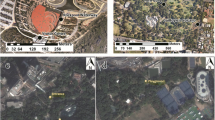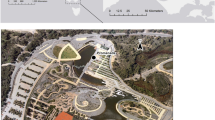Abstract
Humans are at risk from exposure to extremes in their environment, yet there is no consistent way to fully quantify and understand the risk when considering more than just meteorological variables. An outdoor ‘bio-comfort’ threshold is defined for Melbourne, Australia using a combination of heat stress, air particulate concentration and grass pollen count, where comfortable conditions imply an ideal range of temperature, humidity and wind speed, acceptable levels of air particulates and a low pollen count. This is a new approach to defining the comfort of human populations. While other works have looked into the separate impacts of different variables, this is the first time that a unified bio-comfort threshold is suggested. Composite maps of surface pressure are used to illustrate the genesis and evolution of the atmospheric structures conducive to an uncomfortable day. When there is an uncomfortable day due to heat stress conditions in Melbourne, there is a high pressure anomaly to the east bringing warm air from the northern interior of Australia. This anomaly is part of a slow moving blocking high originating over the Indian Ocean. Uncomfortable days due to high particulate levels have an approaching cold front. However, for air particulate cases during the cold season there are stable atmospheric conditions enhanced by a blocking high emanating from Australia and linking with the Antarctic continent. Finally, when grass pollen levels are high, there are northerly winds carrying the pollen from rural grass lands to Melbourne, due to a stationary trough of low pressure inland. Analysis into days with multiple types of stress revealed that the atmospheric signals associated with each type of discomfort are present regardless of whether the day is uncomfortable due to one or multiple variables. Therefore, these bio-comfort results are significant because they offer a degree of predictability for future uncomfortable days in Melbourne.











Similar content being viewed by others
References
Anderson GB, Bell ML (2011) Heat waves in the United States: mortality risk during heat waves and effect modification by heat wave characteristics in 43 US communities. Environ Health Perspect 119:210–218
Antépara J, Fernández JC, Gamboa P, Jauregui I, Miguel F (1995) Pollen allergy in the Bilbao area (European Atlantic Seaboard Climate): pollen forecasting methods. Clin Exp Allergy 25:133–140
Barnett AG, Williams GM, Schwartz J, Neller AH, Best TL, Petroeschevsky AL, Simpson RW (2005) Air pollution and child respiratory health: a case-crossover study in Australia and New Zealand. Am J Respir Crit Care Med 171:1272–1278
Basu R, Samet JM (2002) Relation between elevated ambient temperature and mortality: a review of the epidemiologic evidence. Epidemiol Rev 24:190–202
Bi P, Williams S, Loughnan M, Lloyd G, Hansen A, Kjellstron T, Dear K, Saniotis A (2011) The effects of extreme heat on human mortality and morbidity in Australia: implications for public health. Asia Pac J Public Health 23:27S–36S
Bröde P, Fiala D, Błazejczyk K, Holmer I, Jendritzky G, Kampmann B, Tinz B, Havenith G (2012) Deriving the operational procedure for the Universal Thermal Climate Index (UTCI). Int J Biometeorol 56:481–494
Brunekreef B, Annesi-Maesano I, Ayres JG, Forastiere F, Forsberg B, Künzli N, Pekkanen J, Sigsgaard T (2012) Ten principles for clean air. Eur Respir J 39:525–528
Curriero FC, Heiner KS, Samet JM, Zeger SL, Strug L, Patz JA (2002) Temperature and mortality in 11 cities of the Eastern United States. Am J Epidemiol 155:80–87
de Morton J, Bye J, Pezza A, Newbigin E (2011) On the causes of variability in amounts of airborne grass pollen in Melbourne, Australia. Int J Biometeorol 55:613–622
Dee DP, Uppala SM, Simmons AJ et al (2011) The ERA-Interim reanalysis: configuration and performance of the data assimilation system. Q J R Meteorol Soc 137:553–597
Delaney W, Marshall A (2006) Clean Air Society of Australia and New Zealand. Proceedings 20th International Clean Air and Environment Conference, Auckland, New Zealand, August 2011
Dockery DW, Pope CA III (1994) Acute respiratory effects of particulate air pollution. Annu Rev Public Health 15:107–132
EPA Victoria (2011) Air Monitoring Report 2010—Compliance With The National Environment Protection (Ambient Air Quality) Measure. http://epanote2.epa.vic.gov.au/EPA%5Cpublications.nsf/PubDocsLU/1390?OpenDocument. Accessed 27 June 2012
Erbas B, Chang J-H, Dharmage S, Ong EK, Hyndman R, Newbigin E, Abramson M (2007) Do levels of airborne grass pollen influence asthma hospital admissions? Clin Exp Allergy 37:1641–1647
Filleul L, Cassadou S, Médina S, Fabres P, Lefranc A, Eilstein D, Le Tertre A, Pascal L, Chardon B, Blanchard M, Declercq C, Jusot JF, Prouvost H, Ledrans M (2006) The relation between temperature, ozone, and mortality in nine French cities during the heatwave of 2003. Environ Health Perspect 4:1344–1347
Gaffen DJ, Ross RJ (1998) Increased summertime heat stress in the US. Nature 396:529–530
Gioulekas D, Papakosta D, Damialis A, Spieksma F, Giouleka P, Patakas D (2004) Allergenic pollen records (15 years) and sensitization in patients with respiratory allergy in Thessaloniki, Greece. Allergy 59:174–184
Gold E (1936) Wind in Britain. Q J R Meteorol Soc 62:167–206
Gorman J (2004) The conservation equation of the Synchrotac 706 anemometer: Instrumental test report 677. Bureau of Meteorology, Australia
Gosling S, McGregor G, Páldy A (2007) Climate change and heat-related mortality in six cities. Part 1: model construction and validation. Int J Biometeorol 51:525–540
Hansen A, Bi P, Nitschke M, Pisaniello D, Ryan P, Sullivan T, Barnett A (2012) Particulate air pollution and cardiorespiratory hospital admissions in a temperate Australian city: A case-crossover analysis. Sci Total Environ 416:48–52
Hyde HA (1972) Atmospheric pollen and spores in relation to allergy. Clin Allergy 2:153–179
Jakob D (2010) Challenges in developing a high-quality surface wind-speed data-set for Australia. Aust Meteorol Oceanogr J 60:227–236
Johnson H, Kovats RS, McGregor G, Stedman J, Gibbs M, Walton H, Cook L, Black E (2005) The impact of the 2003 heat wave on mortality and hospital admission in England. Health Stat Q 25:6–11
Laaidi K, Zeghnoun A, Dousset B, Bretin P, Vandentorren S, Giraudet E, Beaudeau P (2012) The impact of heat islands on mortality in Paris during the August 2003 heat wave. Environ Health Perspect 120:254–259
Li B, Sain S, Mearns L, Anderson H, Kovats S, Ebi K, Bekkedal M, Kanarek M, Patz J (2012) The impact of extreme heat on morbidity in Milwaukee, Wisconsin. Clim Chang 110:959–976
Linares C, Díaz J (2008) Impact of high temperatures on hospital admissions: comparative analysis with previous studies about mortality (Madrid). Eur J Public Health 18:317–322
Loughnan ME, Nicholls N, Tapper N (2010) When the heat is on: threshold temperatures for AMI admissions to hospital in Melbourne Australia. Appl Geogr 30:63–69
Mendina-Ramón M, Zanobetti A, Cavanagh DP, Schwartz J (2006) Extreme temperatures and mortality: assessing effect modification by personal characteristics and specific cause of death in a multi-city case-only analysis. Environ Health Perspect 114:1331–1336
Nicholls N, Skinner C, Loughnan M, Tapper N (2008) A simple heat alert system for Melbourne, Australia. Int J Biometeorol 52:375–384
OFCM (2003) Report on Wind Chill Temperature and extreme heat indices: evaluation and improvement projects. U.S. Department of Commerce / National Oceanic and Atmospheric Administration, Office of the Federal Coordinator for Meteorological Services and Supporting Research, FCM-R19-2003, Washington, DC
Ong E, Singh M, Knox R (1995) Seasonal distribution of pollen in the atmosphere of Mebourne: an airborne pollen calendar. Aerobiologica 11:51–55
Pantavou K, Theoharatos G, Nikolopoulos G, Katavoutas G, Asimakopoulos D (2008) Evaluation of thermal discomfort in Athens territory and its effect on the daily number of recorded patients at hospitals’ emergency rooms. Int J Biometeorol 52:773–778
Papanastasiou DK, Melas D (2009) Climatology and impact on air quality of sea breeze in an urban coastal environment. Int J Climatol 29:305–315
Papanastasiou DK, Melas D, Bartzanas T, Kittas C (2010) Temperature, comfort and pollution levels during heat waves and the role of sea breeze. Int J Biometeorol 54:307–317
Pezza A, van Rensch P, Cai W (2012) Severe heat waves in Southern Australia: synoptic climatology and large scale connections. Clim Dyn 38:209–224
Ren C, Tong S (2006) Temperature modifies the health effects of particulate matter in Brisbane, Australia. Int J Biometeorol 51:87–96
Schaffer A, Muscatello D, Broome R, Corbett S, Smith W (2012) Emergency department visits, ambulance calls, and mortality associated with an exceptional heat wave in Sydney, Australia, 2011: a time-series analysis. Environ Health 11:3
Schäppi G, Taylor P, Kenrick J, Staff I, Suphioglu C (1998) Predicting the grass pollen count from meteorological data with regard to estimating the severity of hayfever symptoms in Melbourne (Australia). Aerobiologia 14:29–37
Séguin J, Berry P (2008) Human Health in a changing climate: A Canadian Assessment of Vulnerabilities and Adaptive Capacity. Synthesis Report, Climate Change and Health Office, Safe Environment Directorate, Health Canada
Simpson R, Williams G, Petroeschevsky A, Best T, Morgan G, Denison L, Hinwood A, Neville G (2005) The short-term effects of air pollution on hospital admissions in four Australian cities. Aust NZ J Public Health 29:213–221
Son JY, Lee JT, Anderson GB, Bell ML (2012) The impact of heat waves on mortality in seven major cities in Korea. Environ Health Perspect 120:566–571
Stafoggia M, Schwartz J, Forastiere F, Perucci CA, SISTI Group (2008) Does temperature modify the association between air pollution and mortality? A multicity case-crossover analysis in Italy. Am J Epidemiol 167:1476–1485
Steadman RG (1979) The assessment of sultriness Part I. J Appl Meteorol 18:861–873
Steadman RG (1994) Norms of Apparent Temperature in Australia. Aust Meteorol Mag 43:1–16
Tobias A, Armstrong B, Zuza I, Gasparrini A, Linares C, Díaz J (2012) Mortality on extreme heat days using official thresholds in Spain: a multi-city time series. BMC Public Health 12:133
Ummenhofer CC, England MH, McIntosh PC, Meyers GA, Pook MJ, Risbey JS, Gupta AS, Taschetto AS (2009) What causes southeast Australia’s worst droughts? Geophys Res Lett 36:L04706. doi:10.1029/2008GL036801
World Health Organisation (2005) WHO Air quality guidelines for particulate matter, ozone, nitrogen dioxide and sulfur dioxide: Global Update 2005
Yaglou CP, Minard D (1957) Control of heat casualties at military training centers. Am Med Assoc Arch Ind Health 16:302–316
Acknowledgements
The authors would like to thank the three anonymous reviewers whose comments and suggestions greatly improved the text. We would also like to thank the Environmental Protection Agency of Victoria and the Australian Bureau of Meteorology for providing PM10 and meteorological data, respectively. We also thank Prof. Ed Newbigin from the School of Botany at the University of Melbourne for useful suggestions and discussions, and for sending the pollen data for Melbourne. A. B. Pezza would like to acknowledge the Australian Research Council for funding parts of this work.
Author information
Authors and Affiliations
Corresponding author
Rights and permissions
About this article
Cite this article
Jacobs, S.J., Pezza, A.B., Barras, V. et al. A new ‘bio-comfort’ perspective for Melbourne based on heat stress, air pollution and pollen. Int J Biometeorol 58, 263–275 (2014). https://doi.org/10.1007/s00484-013-0636-0
Received:
Revised:
Accepted:
Published:
Issue Date:
DOI: https://doi.org/10.1007/s00484-013-0636-0




